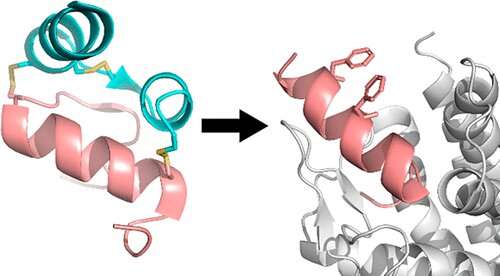This article has been reviewed according to Science X's editorial process and policies. Editors have highlighted the following attributes while ensuring the content's credibility:
fact-checked
peer-reviewed publication
proofread
New stapling method solves floppy peptide problem

In a cutting-edge discovery, published in the Journal of the American Chemical Society, Florey scientists have solved a long-standing problem: the need for an affordable, simple way to make peptide-based drugs that hold their necessary shape.
Professor Akhter Hossain, Head of the Insulin Peptides Group at The Florey, said peptides, the smaller relatives of proteins, are easy to make in a laboratory, have therapeutic potential and are considered safe. However, without the proper structure, the peptides become floppy and inactive.
"Peptides form unique structures that fit like jigsaw pieces into receptors in the brain or elsewhere in the body. They modulate a diverse range of essential bodily functions."
Professor Hossain said our bodies naturally use complicated means of introducing structure into peptides to make them work, which is challenging to replicate in the drug development.
"Peptide stapling has been highly successful in overcoming this problem but the current methods are costly and involve complex chemistry and purification," he said.
The paper's lead author and Head of The Florey's Neurotherapeutics Theme, Professor Ross Bathgate, said by simplifying peptide stapling, the team had turned a multi-step, week-long process into a shorter, single-step one.
"Our new approach is flexible, easy to implement, and will make it easier for researchers and pharmaceutical companies to develop peptide-based drugs. Now we can easily make peptides with the correct structure to bind to their target receptors. Our ultimate goal is for this technology to be used to treat a range of disorders," Professor Bathgate said.
"In our laboratories at The Florey we've used this technology successfully in the earliest stage of drug discovery, and believe it will likely be applicable to a range of potential therapeutic targets for peptide-based drugs," Professor Hossain said.
More information: Ross A. D. Bathgate et al, Noncovalent Peptide Stapling Using Alpha-Methyl-l-Phenylalanine for α-Helical Peptidomimetics, Journal of the American Chemical Society (2023). DOI: 10.1021/jacs.3c02743
Journal information: Journal of the American Chemical Society
Provided by Florey Institute of Neuroscience and Mental Health





















